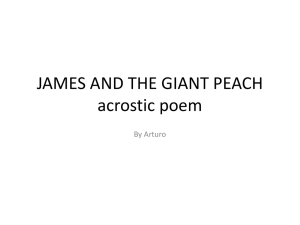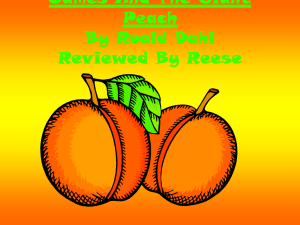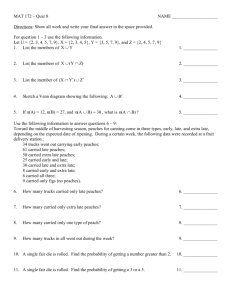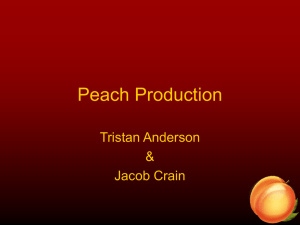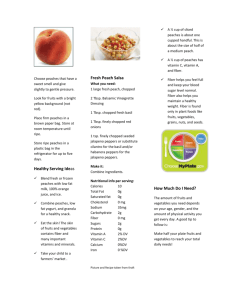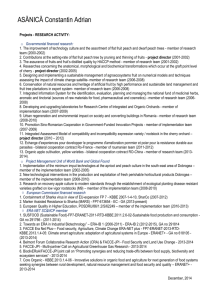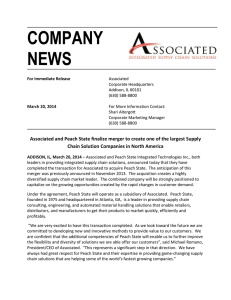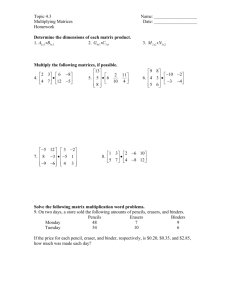PEACHES
advertisement
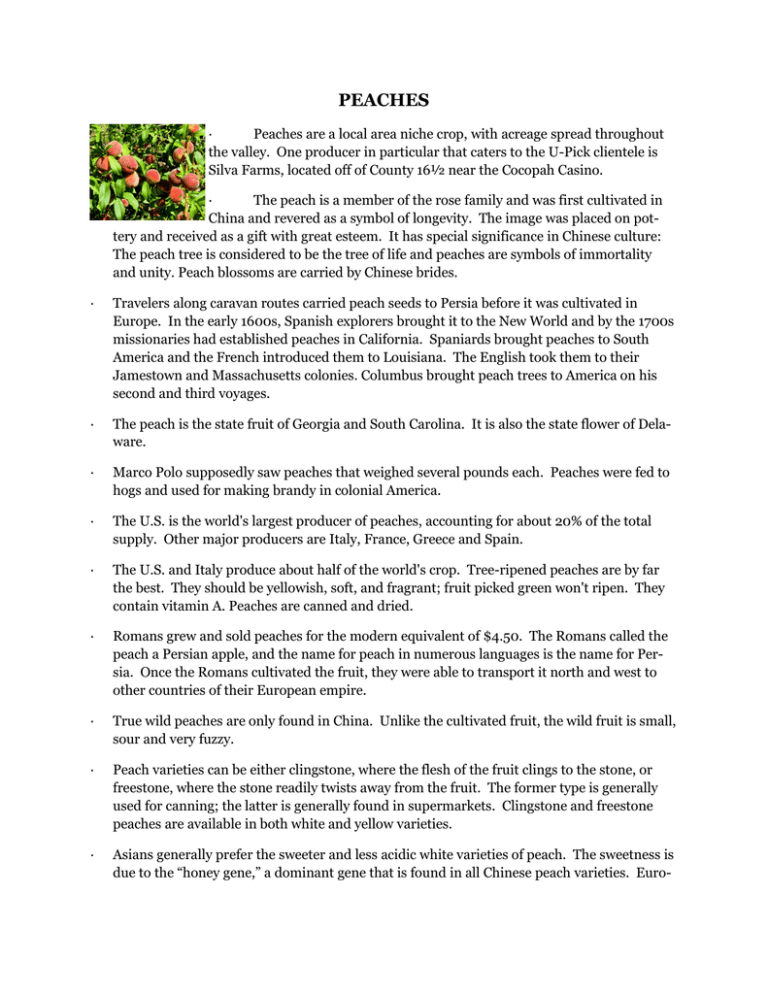
PEACHES · Peaches are a local area niche crop, with acreage spread throughout the valley. One producer in particular that caters to the U-Pick clientele is Silva Farms, located off of County 16½ near the Cocopah Casino. · The peach is a member of the rose family and was first cultivated in China and revered as a symbol of longevity. The image was placed on pottery and received as a gift with great esteem. It has special significance in Chinese culture: The peach tree is considered to be the tree of life and peaches are symbols of immortality and unity. Peach blossoms are carried by Chinese brides. · Travelers along caravan routes carried peach seeds to Persia before it was cultivated in Europe. In the early 1600s, Spanish explorers brought it to the New World and by the 1700s missionaries had established peaches in California. Spaniards brought peaches to South America and the French introduced them to Louisiana. The English took them to their Jamestown and Massachusetts colonies. Columbus brought peach trees to America on his second and third voyages. · The peach is the state fruit of Georgia and South Carolina. It is also the state flower of Delaware. · Marco Polo supposedly saw peaches that weighed several pounds each. Peaches were fed to hogs and used for making brandy in colonial America. · The U.S. is the world's largest producer of peaches, accounting for about 20% of the total supply. Other major producers are Italy, France, Greece and Spain. · The U.S. and Italy produce about half of the world's crop. Tree-ripened peaches are by far the best. They should be yellowish, soft, and fragrant; fruit picked green won't ripen. They contain vitamin A. Peaches are canned and dried. · Romans grew and sold peaches for the modern equivalent of $4.50. The Romans called the peach a Persian apple, and the name for peach in numerous languages is the name for Persia. Once the Romans cultivated the fruit, they were able to transport it north and west to other countries of their European empire. · True wild peaches are only found in China. Unlike the cultivated fruit, the wild fruit is small, sour and very fuzzy. · Peach varieties can be either clingstone, where the flesh of the fruit clings to the stone, or freestone, where the stone readily twists away from the fruit. The former type is generally used for canning; the latter is generally found in supermarkets. Clingstone and freestone peaches are available in both white and yellow varieties. · Asians generally prefer the sweeter and less acidic white varieties of peach. The sweetness is due to the “honey gene,” a dominant gene that is found in all Chinese peach varieties. Euro- peans and Americans have typically cultivated the yellow-skin, yellow-flesh varieties, which have higher acid. · The downy skin of the peach is generally flushed with red coloring, in both yellow and white varieties. The most widely-available peaches are round with a pointed end, but they can also be flat and disc-shaped. The donut peach, which is flat with rounded sides that draw in toward an indented center, like a doughnut without a hole, is a descendant of the flat Chinese peach. · The finest peaches of all are considered to be the pêches de vigne, which are small, redfleshed fruits grown in vineyards in France and generally found only there. Covered with grayish down, they are not particularly attractive, but the flavor is said to be superb. · Peaches are a good source of vitamins A, B and C. A medium peach contains only 37 calories. Sliced, fresh peaches should be tossed in lemon or lime juice to prevent browning. · Nectarines are a variety of peach with a smooth skin, not a cross between a peach and a plum. The nectarine is a variant of peach that has a fuzzless skin. Though grocers treat fuzzy peaches and nectarines as different fruits, they belong to the same species. Nectarines have arisen many times from fuzzy peaches, often as bud sports. Nectarines can be white, yellow, clingstone, or freestone. Regular peach trees occasionally produce a few nectarines, and vice versa. Nectarines are more easily damaged than fuzzy peaches. · The juice from peaches makes a wonderful moisturizer, and it can be found in many brands of cosmetics. · A peach is softer than apples or most other fruit, so it important to pick a peach using the sides of your fingers rather than the tips. If you use the tips of your finger to hold the peach, then you will put little dents in the peach. Using the sides of your fingers is gentler and less likely to cause bruising. Grab the peach firmly and pull it straight off the branch. · The nearly 300 varieties of peaches grown in America have been classified into five races, each with outstanding characteristics, ripening season, and uses. · Raphael Moses, a planter and Confederate officer from Columbus, was among the first to market peaches within Georgia in 1851 and is credited with being the first to ship and sell peaches successfully outside the South. · The peach is a tree, Prunus persica, and the juicy fruit that it bears has a single large seed encased in hard wood (called the pit or stone), yellow or whitish flesh, a delicate aroma, and a velvety skin. Peaches, along with cherries, plums, and apricots, are stone fruits (drupes). · Most peach trees sold by nurseries are grafted cultivars. And, here in the Yuma area growers select those varieties which have a low chill requirement which important in the formation of flowers. Many trees are prone to a disease called leaf curl, which usually does not directly affect the fruit but does reduce the crop yield by partially defoliating the tree. · Peaches, nectarines, plums, apricots, and cherries all members of the Prunus genus, are closely related. They commonly are referred to as "stone fruits" because the seed is very large and hard. In addition, because peaches bloom early in the spring, the flowers could suffer damage from late winter frosts. · Peaches and nectarines produce fruit on new wood, not on spurs, so a good harvest depends upon plenty of new growth. If trees are not pruned annually, the fruiting wood will grow further from the trunk and the ground every year, until the fruit is difficult to pick and the branches become so long that they can be broken easily by the wind or a heavy fruit load. · Basketball's Invention thanks to a peach basket. In December 1891, Canadian-born James Naismith, a physical education teacher at the YMCA training school in Springfield, Mass., took a soccer ball and a peach basket into the gym and invented basketball. In 1893, James Naismith replaced the peach basket with iron hoops and a hammock-style basket. Ten years later came the open-ended nets of today. The 10-foot height on the baskets came about because the first peach baskets were attached to the edge of an elevated running track that happened to be 10 feet off the floor. Kurt Nolte is an area agriculture agent with the Yuma County Cooperative Extension. He can be reached at 928-726-3904.
